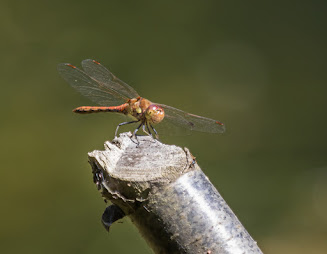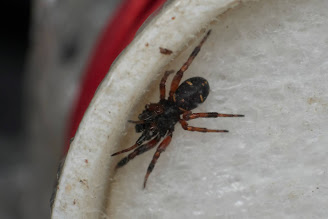Monday, 24th August 2020
At the end of my last report I related the tale of the domestic problems of a swan family. On the same day our spider-man found that he had unexpectedly hired a new company, Earwig Ltd., to take care of his home security.
 |
| Photographs: Nigel Cane-Honeysett |
Less concerned with security was a Forest bug which was sunning itself on the vegetation in his garden
 |
| Photograph: Nigel Cane-Honeysett |
Towards the end of July a visit to Granville Country Park yielded several dragonfly sightings. Among those that posed long enough in their frenzied activities were an Emperor dragonfly which was distracted from the perils of the camera whilst ovipositing:
 |
| Photograph: Peter Hodgkison |
A Migrant hawker passing the time of day just hanging about on a branch:
 |
| Photograph: Peter Hodgkison |
And a couple of Common darters pausing in their continuous search for food and mates.
 |
| Photographs: Peter Hodgkison |
Another Forest bug put in an appearance, this time, drawn by the bright lights, not of Hollywood, but by a moth trap in Dothill.
 |
| Photograph: Neil Nash |
And so, in this strange year, July came to an end and August entered in a blaze of hot sunshine. Unfortunately (or fortunately if you do not like the heat) this spell of weather was short lived to be replaced by frequent often heavy showers, occasional gales and generally much cooler temperatures. My brief spell of single layer of clothing entomology was soon replaced with three of four layers!
In a garden in Edgmond a rather elaborate and colourful caterpillar was spotted. An Alder moth larva.
 |
| Photograph: Jim Shaw |
Around the same time the photographer "snapped" a couple of flies. The first, probably a mosquito or something similar, has wonderful feathery antennae:
 |
| Photograph: Jim Shaw |
The second is a picture wing fly, Paloptera muliebris
If you see this fly at the correct angle you can see, if you are of a certain age and television viewing habits, it has acquired a nickname of the "Dame Edna fly".
 |
| Photograph: Jim Shaw |
I have used the term "nickname" above as I have no idea if it is the fly's "official" common name, but there again is any common name official, surely they arise through common usage rather than designation. I feel a rant coming along, so I will chill out with this lovely moth, also from Edgmond, a Black arches.
 |
| Photograph: Jim Shaw |
On the first Wednesday of August a few people went to Titterstone Clee. I was unable to join them as I was away, but I am told it was very windy on the exposed hill and even windy within the "shelter" of the disused quarry. A very surprising find was a very worn Dark-green fritillary.
 |
| Photograph: David Williams |
I thought that this would have been a very rare find but checking the records on the SEDN database I found that there were quite a large number of records of this butterfly.
Another find on the day was the spider Asagena phalerata, which is a close relative of the infamous and unfairly persecuted Noble false widow spider.
 |
| Photograph: David Williams |
On the Friday I joined a Tanyptera Trust Recording Day at the Altcar Training Camp near Formby.
The Tanyptera Trust project is based at Liverpool Museum and is a similar in scope to the BioLinks project in encouraging biological recording through training and recording days.
Following the gradual easing of the COVID regulations they decided they were able to restart their recording days using policies and practices that allowed visits to take place whilst respecting the guidelines.
Essentially a maximum of 12 recorders could attend, including the project team. The attendees were split into two groups of six. each of the groups operated in different parts of the site and the two groups did not mix socially during the day.
To be perfectly frank all these precautions seemed unnecessary as once we started recording we rarely came into contact with anyone else!
I am now considering whether we can adopt a similar strategy to allow Joy of Wildlife visits to restart. There seems to be no reason why we could not adopt the same approach. However, my main reservation is that we are a far more sociable group than the Tanyptera recorders and introducing the social distancing rules and the maximum groups of six will cause much of the fun we have to be lost. But, perhaps, some form of recorder gathering is better than none.
Back to the visit.
Altcar is a Ministry of Defence establishment that is set amongst the sand dunes to the south of Formby. As such it is an good site for dune specialists, having little disturbance. I had a very successful day , finding several insects that we do not normally find in Shropshire, However I was very lax in my photographic duties and took only one photograph. It was of a pug moth. But, unusually for a pug, one that is easy to identify - a Lime-speck pug.
I think that is enough of my ramblings for this report. I will continue with this miscellany at a later date.
Keep well.


















































